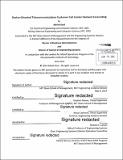| dc.contributor.advisor | Stephen Graves and Bruce Cameron. | en_US |
| dc.contributor.author | Koul, Ashish, 1979- | en_US |
| dc.contributor.other | Leaders for Global Operations Program. | en_US |
| dc.date.accessioned | 2014-10-08T15:29:08Z | |
| dc.date.available | 2014-10-08T15:29:08Z | |
| dc.date.copyright | 2014 | en_US |
| dc.date.issued | 2014 | en_US |
| dc.identifier.uri | http://hdl.handle.net/1721.1/90787 | |
| dc.description | Thesis: M.B.A., Massachusetts Institute of Technology, Sloan School of Management, 2014. In conjunction with the Leaders for Global Operations Program at MIT. | en_US |
| dc.description | Thesis: S.M., Massachusetts Institute of Technology, Engineering Systems Division, 2014. In conjunction with the Leaders for Global Operations Program at MIT. | en_US |
| dc.description | Cataloged from PDF version of thesis. | en_US |
| dc.description | Includes bibliographical references (page 53). | en_US |
| dc.description.abstract | Verizon Wireless maintains a call center infrastructure employing more than 15,000 customer care representatives across the United States. The current resource management process requires a lead time of several months to hire and train new staff for the customer rep position. To ensure that call center resources are balanced with customer demand, an accurate forecast of incoming call volume is required months in advance. The standard forecasting method used at Verizon relies on an analysis of aggregate call volume. By analyzing the growth trend of the customer base and the month-upon-month seasonal fluctuations within each year, the total incoming call volume is predicted several months in advance. While this method can yield solid results, it essentially groups all customers into a single category and assumes uniform customer behavior. Given the size of the Verizon customer base, forecast inaccuracy in the current process can lead to resource allocation errors on the order of tens of thousands of labor hours per month. This thesis proposes a call forecasting model which segments customers according to wireless device type. By taking into consideration customer behavior on a per device basis and accounting for the continuous churn in mobile devices, there is the potential to create a forecasting tool with better accuracy. For each device model, future call volumes are estimated based upon projected device sales and observed customer behavior. Aggregate call volume is determined as the sum across all device models. Linear regression methods are employed to construct forecast models for each of the top 20 mobile devices (those which generate the most customer service calls) using historical device data. The aggregate call volume forecast for these top 20 devices is benchmarked against the standard forecast currently in use at Verizon to validate the reliability of the new approach. Furthermore, device-oriented analytics processes developed for this project will enable Verizon to build a rich library of device data without additional staff or resource investments. By incorporating device-oriented data analysis into the call volume forecasting process, Verizon Wireless hopes to improve forecast accuracy and staff planning, effectively maintaining service levels while reducing overall staffing costs at call centers. | en_US |
| dc.description.statementofresponsibility | by Ashish Koul. | en_US |
| dc.format.extent | 53 pages | en_US |
| dc.language.iso | eng | en_US |
| dc.publisher | Massachusetts Institute of Technology | en_US |
| dc.rights | M.I.T. theses are protected by copyright. They may be viewed from this source for any purpose, but reproduction or distribution in any format is prohibited without written permission. See provided URL for inquiries about permission. | en_US |
| dc.rights.uri | http://dspace.mit.edu/handle/1721.1/7582 | en_US |
| dc.subject | Sloan School of Management. | en_US |
| dc.subject | Engineering Systems Division. | en_US |
| dc.subject | Leaders for Global Operations Program. | en_US |
| dc.title | Device-oriented telecommunications customer call center demand forecasting | en_US |
| dc.type | Thesis | en_US |
| dc.description.degree | M.B.A. | en_US |
| dc.description.degree | S.M. | en_US |
| dc.contributor.department | Leaders for Global Operations Program at MIT | en_US |
| dc.contributor.department | Massachusetts Institute of Technology. Engineering Systems Division | |
| dc.contributor.department | Sloan School of Management | |
| dc.identifier.oclc | 891573019 | en_US |
